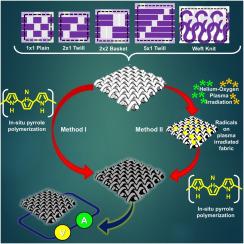当前位置:
X-MOL 学术
›
Synth. Met.
›
论文详情
Our official English website, www.x-mol.net, welcomes your feedback! (Note: you will need to create a separate account there.)
Effect of yarn interlacement pattern on the surface electrical conductivity of intrinsically conductive fabrics
Synthetic Metals ( IF 4.4 ) Pub Date : 2020-10-01 , DOI: 10.1016/j.synthmet.2020.116512 Akanksha Pragya , Smita Deogaonkar-Baride
Synthetic Metals ( IF 4.4 ) Pub Date : 2020-10-01 , DOI: 10.1016/j.synthmet.2020.116512 Akanksha Pragya , Smita Deogaonkar-Baride

|
Abstract The fundamental fabric construction of a conductive textile has a vital impact on its overall electrical properties. In the present study, a comprehensive assessment entailing the influence of yarn interlacement pattern on the surface conductivity of intrinsically conductive fabric (i-CF) has been undertaken. The different interlacement designs, namely, woven 1 × 1 plain, 2 × 2 basket, 2 × 1 twill, 5 × 1 twill, and weft knit single jersey were each prepared using polyester and cotton yarn. Electrical conductivity was imparted to the pristine and He/O2 plasma irradiated textile substrates via in-situ polymerization of polypyrrole (PPy) in an oxidative environment. Additionally, change in yarn surface morphology due to He/O2 plasma irradiation was studied using scanning electron microscopy (SEM), Fourier-transform infrared spectroscopy (FTIR), and X-ray photoelectron spectroscopy (XPS). Surface activation caused by the plasma-treatment enabled a higher PPy uptake and better retention. The enhanced PPy retention was quantified through the abrasion fastness test by measuring i-CF conductivity after 500, 1000, 2000, and 4000 rubbing cycles. In conclusion, it was observed that collectively, woven i-CFs exhibited superior surface conductivity (of order 10−3 – 10-4 Siemens sq.) than the knitted i-CFs (of order 10-6 Siemens sq.). This was primarily due to the high pore size and active ‘canal effect’ in the latter that hampered proper PPy coating and its subsequent retention on the i-CF surface. Besides pore size, factors including crimp %, number of interlacement points, degree of warp/weft float, fabric thickness, and weight add-on % come into play to synergistically determine the resultant properties of the conductive fabrics.
中文翻译:

纱线交织图案对本征导电织物表面电导率的影响
摘要 导电纺织品的基本织物结构对其整体电气性能具有重要影响。在本研究中,进行了一项综合评估,涉及纱线交织模式对本征导电织物 (i-CF) 表面电导率的影响。不同的交织设计,即机织1×1平纹、2×2篮子、2×1斜纹、5×1斜纹和纬编单面针织,均使用涤纶和棉纱制成。通过聚吡咯 (PPy) 在氧化环境中的原位聚合,将导电性赋予原始和 He/O2 等离子体照射的纺织品基材。此外,使用扫描电子显微镜 (SEM) 研究了由于 He/O2 等离子体照射引起的纱线表面形态变化,傅里叶变换红外光谱 (FTIR) 和 X 射线光电子能谱 (XPS)。由等离子体处理引起的表面活化能够实现更高的 PPy 吸收和更好的保留。通过测量 500、1000、2000 和 4000 次摩擦循环后的 i-CF 电导率,通过耐磨性测试来量化增强的 PPy 保留。总之,据观察,总体而言,编织 i-CF 比针织 i-CF(10-6 西门子平方)表现出优异的表面电导率(10-3 – 10-4 西门子平方)。这主要是由于后者的高孔径和活跃的“运河效应”阻碍了适当的 PPy 涂层及其随后在 i-CF 表面上的保留。除孔径外,还包括卷曲百分比、交织点数、经纬浮度、织物厚度、
更新日期:2020-10-01
中文翻译:

纱线交织图案对本征导电织物表面电导率的影响
摘要 导电纺织品的基本织物结构对其整体电气性能具有重要影响。在本研究中,进行了一项综合评估,涉及纱线交织模式对本征导电织物 (i-CF) 表面电导率的影响。不同的交织设计,即机织1×1平纹、2×2篮子、2×1斜纹、5×1斜纹和纬编单面针织,均使用涤纶和棉纱制成。通过聚吡咯 (PPy) 在氧化环境中的原位聚合,将导电性赋予原始和 He/O2 等离子体照射的纺织品基材。此外,使用扫描电子显微镜 (SEM) 研究了由于 He/O2 等离子体照射引起的纱线表面形态变化,傅里叶变换红外光谱 (FTIR) 和 X 射线光电子能谱 (XPS)。由等离子体处理引起的表面活化能够实现更高的 PPy 吸收和更好的保留。通过测量 500、1000、2000 和 4000 次摩擦循环后的 i-CF 电导率,通过耐磨性测试来量化增强的 PPy 保留。总之,据观察,总体而言,编织 i-CF 比针织 i-CF(10-6 西门子平方)表现出优异的表面电导率(10-3 – 10-4 西门子平方)。这主要是由于后者的高孔径和活跃的“运河效应”阻碍了适当的 PPy 涂层及其随后在 i-CF 表面上的保留。除孔径外,还包括卷曲百分比、交织点数、经纬浮度、织物厚度、


























 京公网安备 11010802027423号
京公网安备 11010802027423号